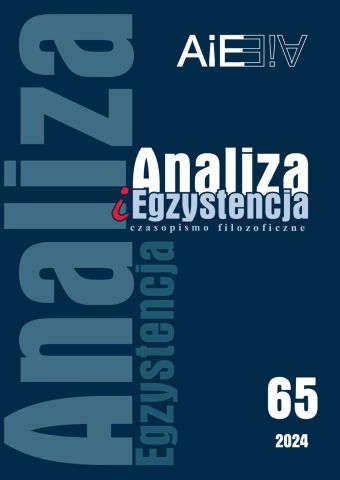
ISSN: 1734-9923
eISSN: 2300-7621
OAI
DOI: 10.18276/aie.2024.65-03





Issue archive /
65 (2024)
The ambiguous beginning of life and the binary pattern – a phenomenological analysis of intersexual experience
| Authors: |
Anna
Alichniewicz

Uniwersytet Medyczny w Łodzi |
| Keywords: | indeterminacy horizon homeworld lifeworld binary pattern intersexuality lived body |
| Data publikacji całości: | 2024 |
| Page range: | 15 (35-49) |
Abstract
In my paper, I attempt a phenomenological analysis of the lived experience of intersexuality, which I view from the perspective of the problem of indeterminacy concerning the horizon of the givenness of homeworld founded on the broader basis of the pre-givenness of lifeworld. These horizons define the structure of the sedimentation of subjective experience, as well as the layers of cultural meanings sedimented in the lifeworld. The sedimented layers of self-experience and of the shared lifeworld function as a sphere of indeterminacy, that is the horizons of constituted phenomena. In this sense all intentional acts have the nature of horizontal indeterminacy, the layers of which are revealed in the genetic question (Rückfrage) directed toward them. Horizontal indeterminacy also accounts for the distinction between homeworld and alienworld, which appears as something unobvious and unexpected against the obviousness of the homeworld, at the same time thematizing the latter. One of the elements of the sedimented conceptual system, functioning as the horizon of indeterminacy of both self-experience and the pre-reflective life-world, is the notion of human corporeality as given in the binary sexuality/gender. A unique opportunity for phenomenological insight into the constitution of the phenomenon of sex/gender is provided by Hida Viloria's lived experience of intersexuality. Her lived body, originally experienced pre-reflectively as a transparent medium and a perfectly handy tool of undisturbed intentionality, unproblematized also in the sexual activities, gradually undergoes alienation under the objectifying gaze determined by the binary pattern of sexuality. Becoming an alienated object, her body loses its transparency. Viloria begins to experience her corporeality and identity in a way determined by the sedimented "ideology" of sex and gender, trying on the "constructs" of masculine and feminine identities, eventually overcoming alienation and, in a process of secondary self-identification, reclaiming her lived body in its intersexuality and her identity in its non-binary gender fluidity.
Download file
Article file
Bibliography
| 1. | References |
| 2. | Boylan, J. F.(2003). She’s Not There: A Life in Two Genders. New York: Crown. |
| 3. | Boylan, J.F. (2020). Good Boy: My Life in seven Dogs. New York: Celadon Books. |
| 4. | Carl, P. (2020). Becoming a Man. The Story of a Transition. New York: Simon & Schuster. |
| 5. | Dreger, A. D. (1998). Hermaphrodites and the Medical Invention of Sex. Cambridge, MA-London, UK: Harvard University Press. |
| 6. | Flor, N. G., S. García Dauder, I. Hurtado García. (2018). Bioethics and Intersex: “Time out”. A paradigm shif on Intersex Management in the Spanish context. Athenea Digital, 18(2), e1899. |
| 7. | https://doi.org/10.5565/rev/athenea.1899 |
| 8. | Gallagher S., D. Zahavi. (2012). The Phenomenological Mind. London and New York: Routledge. |
| 9. | Grover, S. R., C. A. Hanna, M. A. O’Connell. (2020). Introduction: Changing Landscapes. In: Disorders/Differences of Sex Development. An Integrated Approach to Management, eds. J. M. Hutson, S. R. Grover, M. A. O’Connell, A. Bouty, C. A. Hanna. Singapore: Springer Nature. |
| 10. | Grodzka, A. (2013). Mam na imię Ania. Warszawa: Wydawnictwo WAB. |
| 11. | Husserl, E. (1970). The Crisis of European Sciences and Transcendental Phenomenology: An Introduction to Phenomenology. Trans. D. Carr. Evanston, IL: Northwestern University Press. |
| 12. | Husserl, E. (1982) Ideas Pertaining to a Pure Phenomenology and to a Phenomenological Philosophy, First Book: General Introduction to a Pure Phenomenology. Trans. F. Kersten. The Hague: Martinus Nijhoff. |
| 13. | Husserl, E. (1989). Ideas Pertaining to a Pure Phenomenology and to a Phenomenological Philosophy, Second Book: Studies in the Phenomenology of Constitution. Trans. R. Rojcewicz and A. Schuwer. Dordrecht-Boston-London: Kluwer Academic Publishers. |
| 14. | Hutson, J. M., S. R. Grover, M. A. O’Connell, A. Bouty, C. A. Hanna, eds. (2020). Disorders/Differences of Sex Development. An Integrated Approach to Management. Singapore: Springer Nature. |
| 15. | Laqueur, T. (1992). Making Sex. Body and Gender from the Greeks to Freud. Cambridge, MA-London, UK: Harvard University Press. |
| 16. | Merleau-Ponty, M. (2002). Phenomenology of Perception. London and New York: Routledge. |
| 17. | Morris, J. (1974). Conundrum. New York: New York Review Book. |
| 18. | Donohue, J. (2019). Genetic Phenomenology and the Indeterminacy of Racism. In: The Significance of Indeterminacy. Perspectives from Asian and Continental Philosophy, eds. R.H. Scott, G.S. Moss. New York-London: Routledge. |
| 19. | Roen, K. (2005). Queer Kids: Toward Ethical Clinical Interactions with Intersex People. In: Ethics of the Body. Postconventional Challenges, eds. M. Shildrick, R. Mykitiuk. Cambridge MA – London, England: The MIT Press. |
| 20. | Sartre, J.-P. (1956). Being and Nothingness: A Phenomenological Essay on Ontology. Trans. H. E. Barnes. New York: Pocket Books. |
| 21. | Talusan, M. (2020) Fairest. A Memoir. New York: Viking. |
| 22. | Toombs, S. K. (1992). The Meaning of Illness. A Phenomenological Account of the Different Perspectives of Physician and Patient. Dordrecht-Boston-London: Kluwer Academic Publishers. |
| 23. | Viloria, H. (2017). Born Both. An Intersex Life. New York-Boston: Hachette Books. |
| 24. | Viloria, H., Nieto M. (2020). The Spectrum of Sex .The Science of Male, Female, and Intersex. London-Philadelphia: Jessica Kingsley Publishers. |
| 25. | Ziemińska, R. (2018a). Beyond Dimorphism: Intersex Persons and the Continuum of Sex Characteristics. International Journal of Gender and Women’s, 1(6), 176-184. |
| 26. | Ziemińska, R. (2018b). Niebinarne i wielowarstwowe pojęcie płci. Warszawa: Wydawnictwo Naukowe PWN. |
| 27. | Ziemińska, R. (2022). Toward a Nonbinary Model of Gender/Sex Traits. Hypatia, 37, 402-421, doi: 10.1017/hyp.2022.10 |